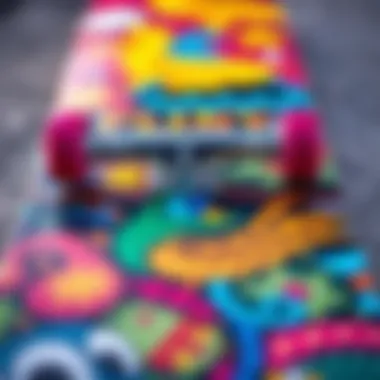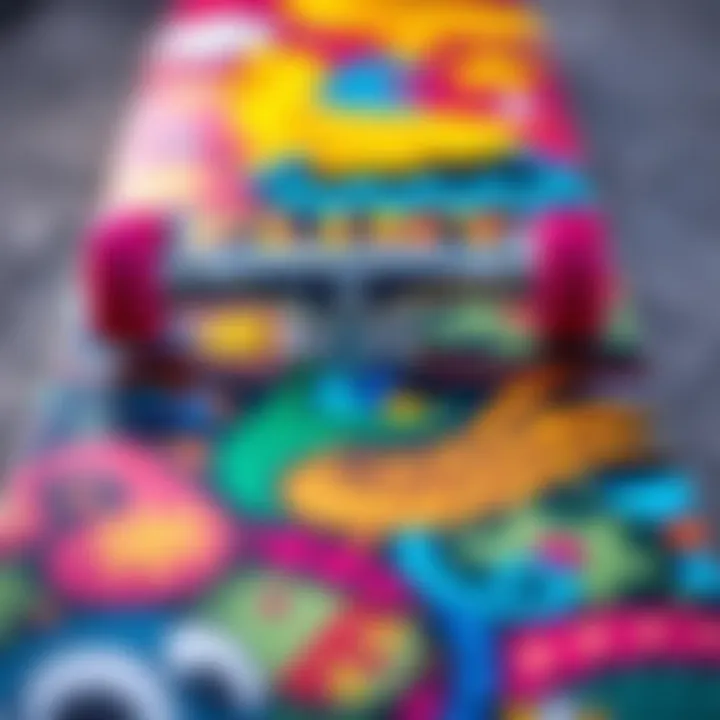Exploring Penny Skateboards: Design and Culture


Intro
Penny skateboards have made waves in the skateboarding scene, standing out due to their compact size and vibrant designs. These skateboards, often made of durable plastic, cater to a wide range of riders, from beginners just finding their footing to seasoned skaters seeking a versatile ride. In understanding the world of penny skateboards, we unearth various layers of their appeal—how they fit into the lifestyle of skaters, their unique riding characteristics, and the broader cultural significance they bear.
The allure of penny skateboards isn't just about their eye-catching colors or portability; it also lies in the community that rallies around them. For many, it's more than just a mode of transport—it's a means of expression and creativity, almost like an extension of the self. This article endeavors to peel back the layers of the penny skateboard phenomenon, examining key aspects from skills development to gear insights that can elevate a skater's experience.
By diving into skill-building strategies and practical gear recommendations, our aim is to provide a comprehensive resource for skaters of all levels. Whether you're working on perfecting a trick or just want to keep your skateboard in top shape, there’s something here for everyone.
Penny Skateboards: An Overview
Understanding penny skateboards is essential for anyone who seeks to navigate the dynamic landscape of skateboarding. These compact, colorful boards have carved out a significant niche in the skateboarding world, appealing not only to seasoned skaters but also to newcomers looking for a fusion of fun and functionality. Popularity stems from their unique attributes, which range from lightweight construction to artistic designs, making them particularly suitable for urban environments.
Recognizing what distinguishes penny skateboards offers insights into their broad appeal. They encapsulate a sense of freedom and creativity, resonating well with the vibrant culture surrounding skateboarding. Additionally, commuters and casual riders find themselves drawn to the ease of transport and storage that penny boards provide. Thus, understanding the underlying features of these boards is not just beneficial for enthusiasts; it also highlights broader trends in urban transportation and youth culture.
Definition and Origin
Penny skateboards trace their roots back to the 1970s, a time when skateboarding began to transition from simple wooden planks to more sophisticated designs. Originally coined as an umbrella term, "penny boards" generally refer to a shorter, plastic skateboard known for its small size and molded construction, offering a different ride and feel compared to traditional skateboards. Initially designed with simplicity in mind, these boards emerged as iconic symbols of the Californian surf and skate culture, a representation of freedom on wheels.
Over the years, the term "Penny" became synonymous with the Australian brand Penny Skateboards, which reignited interest in these compact boards in the early 2000s. The company has since played a pivotal role in cementing the penny board's place in skateboarding history, combining nostalgia with modern design.
Key Characteristics
Material Composition
The material composition of penny skateboards is largely plastic, which significantly contributes to their lightweight and flexible characteristics. This choice of material allows for a high degree of maneuverability, a factor that many beginners appreciate while learning to skate. Plastic boards withstand the test of time better than many wooden alternatives, as they resist warping and can endure damp weather far more effectively.
While the plastic construction provides a vibrant array of colors and patterns that appeal to many skaters, it can also pose some drawbacks. Some enthusiasts argue that plastic lacks the feel and stability of wood, making tricks more challenging to execute.
Design Elements
Penny skateboard designs typically favor aesthetics, with a variety of bright colors and eye-catching graphics. The classic shapes—characterized by their short deck and distinct concave—enable swift turns and tricks, appealing to those with a creative edge. The compact form makes them especially stylish and fun for urban environments, allowing for easy maneuverability through tight spaces.
However, these unique design elements might not suit skaters looking for a functional board for extensive skate sessions or serious tricks. The emphasis on style can distract from the technical performance when compared to more traditional boards designed with advanced features.
Wheel Specifications
The specifications of wheels on penny skateboards also suggest a balance between speed and control. Typically smaller than traditional skateboard wheels, the harder durometer wheels allow for a quicker ride but can be less forgiving on rough terrain. This characteristic is crucial for riders who prefer faster cruising, making them popular among urban skaters navigating city streets.
On the flip side, the smaller wheels may not provide the best performance on rougher surfaces, limiting their versatility. Riders tackling diverse environments might need to consider these aspects when choosing a penny board.
"The uniqueness of penny skateboards converges with their challengess, making them a compelling choice in the skating world."
In summary, penny skateboards embody a distinct blend of style, functionality, and cultural relevance. Their unique characteristics offer a plethora of options for both newcomers and seasoned riders, keeping them a constant topic of interest in skateboarding discussions.
The Appeal of Penny Skateboards
The world of penny skateboards is not just about simple transportation; it’s an alluring blend of practicality, style, and culture that resonates with skaters of all ages. There are unique elements driving this appeal, making penny skateboards a favorite choice for urban commuting and leisure alike.
Compact Design
One of the most striking features of penny skateboards is their compact design, which is often a game changer for riders. Standing out for their minimal profile, these boards don’t just look good—they make maneuvering through tight city spaces significantly easier compared to traditional skateboards.
Being lightweight and small facilitates carrying them around. When you’re squeezing onto a crowded bus or darting through busy streets, the ability to stow your skateboard under your arm or in a backpack is invaluable. Their size is also a boon for novice skaters. As beginners often find larger boards cumbersome, penny skateboards offer an accessible entry point into riding.
Additionally, penny skateboards come in a variety of vibrant colors and unique designs, appealing to those who want to make a statement. This adaptability allows riders to customize their boards to match their personality, from eye-catching patterns to subtle hues.
Cultural Influence
Association with Urban Youth
Penny skateboards have nestled themselves into the heart of urban culture, particularly among youth. They symbolize not only a mode of transport but also a lifestyle, reflecting a sense of freedom and rebellion commonly associated with skateboarding as a whole. Within cities, these boards are often seen zipping alongside bikes, blending seamlessly into the hustle and bustle of city life. This integration emphasizes the board’s functionalities while also strengthening its cultural ties.
The popular association of penny skateboards with urban youth stems largely from their affordability and accessibility. Many young skaters can pick up a penny board without breaking the bank, making it a feasible option for those eager to dive into the skateboarding scene. Furthermore, platforms like Instagram and TikTok have ignited a trend focusing on stylish skateboarding, showcasing how riders incorporate them into everyday life. The visual aspect of skating, combined with a simple yet impactful board design, allows for engaging content creation.
The Rise in Popularity
While penny skateboards have been around since the 1970s, their recent surge in popularity can be attributed to a few key factors. Most notably, as urban environments grow more congested, there’s been a renewed interest in alternative modes of transport. Penny boards, known for their convenience, allow riders to bypass traffic snarls and get to destinations quicker, feeding into the current trend of sustainable transport solutions.
Moreover, social media channels serve as amplifiers for trends; riders showcase tricks, paths, and styles linked with these boards, which influences their peers. The hashtag #pennyskateboard often brings together a community of enthusiasts eager to share tips, tricks, and experiences.
However, it’s essential to remember that the popularity also raises questions around safety and skateboarding culture. Increased visibility means more people are taking up the sport, but it also leads to more inexperienced riders on the streets. Beginners need to be aware of their surroundings and skate in safe environments to enjoy all the benefits these boards have to offer.
In summary, the appeal of penny skateboards is multi-dimensional, encompassing practical aspects such as compactness and cultural significance resonating with youth.
For references and more information, check out sources like Wikipedia and Reddit.
Penny skateboards serve as a canvas, not just for personal expression through design but also for the various cultural narratives they embody.
Riding Techniques for Penny Skateboards


Understanding the right riding techniques is crucial for any skateboarder, especially when it comes to penny skateboards. These compact boards have specific dynamics that differ from traditional skateboards. Mastering various riding techniques not only enhances the experience but also builds the rider's confidence and safety on the board. With a bit of practice, one can effortlessly glide through the streets, making the most of a penny skateboard's unique features.
Basic Riding Skills
Proper Stance
The proper stance is pivotal in establishing a solid foundation while riding a penny skateboard. It's about how you position your feet on the board while maintaining balance and control. This is not just about comfort; it's about maximizing stability and maneuverability. Typically, a rider should position their feet directly over the trucks, ensuring that weight is evenly distributed.
The key characteristic of a proper stance is its adaptability. Riders can choose to ride regular (left foot forward) or goofy (right foot forward), whichever feels more comfortable. A beneficial aspect of this stance is that it allows for quick adjustments during riding, making tricks easier to execute. However, it takes time to find that sweet spot where one feels most natural and in control.
Balancing Techniques
Balancing techniques are essential for riding a penny skateboard effectively. One common method involves shifting your weight slightly forward or backward. This subtle adjustment can help navigate turns or maintain pace. The key characteristic of good balancing techniques is responsiveness; the rider must learn to feel how the board reacts to weight shifts.
Having well-developed balancing techniques can be a game changer. It greatly enhances a rider's ability to stay on the board, especially when hitting rough patches or performing tricks. However, some may find this challenging, as it requires a keen awareness of body positioning and board dynamics.
Advanced Tricks
Ollies
The ollie is a fundamental trick that serves as the foundation for many advanced moves. It involves a jump off the board while simultaneously popping the tail down and dragging the foot upwards. This trick allows a rider to hop over obstacles or gain elevation when performing tricks.
What makes the ollie a beneficial technique for penny skateboarders is its versatility; it can be combined with numerous other tricks to expand a rider's repertoire. However, mastering the timing of the pop and drag can prove tricky for beginners.
Noseslides
Noseslides are often regarded as a signature move for many skateboarders. This trick involves sliding the nose of the board across a rail or ledge, requiring precision and control. The appeal of noseslides lies in their fluidity and the stylish nature of the trick.
The basic feature of noseslides is their emphasis on balance and timing. They require a good understanding of how the board moves and reacts when sliding. While the reward is impressive, the risk of falling is higher due to the balance needed, a consideration for those just starting out.
Shuvits
Shuvits, or shuvs, are another key trick that involves spinning the board 180 degrees beneath the rider's feet while remaining in the air. This trick has a unique appeal due to its visual impact; it can catch the eye and showcase a rider's skill. Shuvits are fun yet demanding, as they require precise footwork and a confident stance.
What sets shuvits apart is the degree of control a rider must have during the trick. Practicing them helps develop agility and gives a rider more control over the board in various riding situations. The trick can also be challenging, especially finding the right timing to perform it correctly without losing balance.
Selecting the Right Penny Skateboard
Choosing the correct penny skateboard is more than simply picking a colorful board off the shelf. Each rider's preferences and needs play a crucial role in ensuring a satisfying experience. Selecting the right skateboard hinges on three main aspects: the rider's skill level, intended use, and design preferences. A solid understanding of these factors can lead to better rides, minimized accidents, and enhanced enjoyment.
Factors to Consider
Rider's Skill Level
Rider's skill level acts as the foundation for any good selection process. Whether you’re a fledgling rider or an experienced skater, your skill determines what board suits you best. A beginner might benefit from boards that offer stability over high maneuverability. These boards usually have a wider stance for improved balance. They let novice riders build confidence as they learn to push off, steer, and stop without too much fuss.
Conversely, a more advanced rider might look for boards equipped for tricks or carving. These boards often come with a slimmer design, making performing tricks like ollies or shuvits easier. However, they provide less stability, which could be risky for those still finding their balance. So, knowing your riding level is key to picking the right board and helps in avoiding unnecessary tumbles.
Intended Use
When considering your intended use, it’s essential to recognize how and where you plan to ride. Urban environments demand boards that can handle rough terrain, making wider wheels a better choice for a smoother ride over cracks and bumps. If you plan mainly cruising around your local park or on flat surfaces, a compact, lightweight board might do the trick, allowing for easy transport and maneuverability.
Another angle to think about is your purpose for skating. Are you looking for a leisurely cruise, some tricks at the skate park, or maybe street skating? Each style calls for different specifications and understanding your goals can significantly influence your choice. Picking a board that aligns with your intended use ensures you’ll get the most joy out of your investment.
Design Preferences
The aesthetic aspect may seem superficial, but design preferences can influence not just the look of your board but also its functionality. Bright colors and unique graphics can reflect your personality, making the ride feel more customized. Having a board that visually resonates with you can boost your confidence as a skater.
Moreover, the design impacts performance. A smaller deck is easier to carry around and flick around while doing tricks. However, larger decks provide more space to place your feet, possibly aiding stability during rides. Knowing the balance between design and practicality can help buyers avoid any mismatches and frustrations down the line.
Popular Brands and Models
Review of Top Picks
When talking about the leading brands in the penny board sphere, options continue to grow, offering great choices based on skill levels and aesthetic preferences. Brands like Penny Australia have a strong following due to their emphasis on quality and eye-catching designs. Their products don’t compromise on durability or style. On the other hand, brands such as Globe focus on sleek designs but excel in offering a unique riding experience through their innovative engineering.
Making a choice from reputable brands ensures a certain level of quality and customer support, essential for any skateboarder, especially those new to the sport. When considering options, checking online reviews and seeking advice from local skate shops can go a long way in helping you choose the best board for your needs.
Comparative Analysis
In the world of skateboarding, comparative analysis is essential for making informed decisions. In comparing two or more models, factors such as price, durability, and user experience all come into the picture. For instance, you might compare a classic Penny board with a variant from a competing brand, assessing their width, wheel quality, and the type of riding each supports.
One advantage of a comparative analysis shows not just differences in features but also insights into community experiences. People often discuss longevity, performance during various riding conditions, and ease of transport. Online forums, like those on Reddit, provide a platform for sharing both success stories and pitfalls, thus aiding potential buyers in navigating their options effectively.
"The right penny skateboard doesn’t just take you for a ride; it becomes a part of your lifestyle. Choose wisely to ensure the board enhances your experience."
Ultimately, focusing on these aspects will lead to a more cohesive selection process, paving the way for enjoyable rides that match your needs.
Maintaining Your Penny Skateboard


In the vibrant world of penny skateboards, maintenance plays a vital role in ensuring the longevity and performance of the board. Without routine upkeep, even the best boards can whittle away under the pressures of daily cruising and tricks. Understanding the nuances of maintenance not only enhances your ride but can also significantly improve safety and performance. Each component, from wheels to trucks, requires specific attention, making it essential for skaters to grasp the importance of keeping their skateboards in top shape.
Regular Maintenance Practices
Changing Wheels
The act of changing wheels on a penny skateboard is not just a chore but a necessary practice for maintaining an optimal riding experience. Over time, wheels can wear down significantly, leading to poor performance and decreased stability. Fresh wheels help to enhance grip and provide a smoother ride, which is crucial for those seeking to master nuances in their skating style.
A key characteristic of wheels is their durometer rating, which dictates how hard or soft a wheel is. Softer wheels tend to grip better on rough surfaces, making them a favorite among street skaters. However, the more you use the board on rough terrains, the faster the wheels will degrade. A beneficial choice in this context is the use of durable urethane wheels, which provide resilience against wear while ensuring good performance.
Moreover, the unique feature of easily interchangeable wheels adds adaptability to your penny skateboard setup. Riders can switch between wheel sizes or durometers to fit varying conditions or personal preferences.
Advantages of regularly changing wheels include improved speed and handling, whereas one of the notable disadvantages might be the cost of continually purchasing new sets.
Cleaning Techniques
Cleaning a penny skateboard is an essential aspect of its maintenance that can easily be overlooked. Dirt and debris can accumulate not only on the surface but also in the bearings, which can lead to rust and reduced performance. Regular cleaning not only helps maintain aesthetics but also ensures the board operates smoothly.
A significant aspect of effective cleaning techniques involves the use of gentle detergents or specialized skateboard cleaners. This avoids damaging the board's finish or materials. Ensuring that hardware like screws and bolts are kept free of grime allows for easier adjustments and ensures a safer ride.
Through a systematic cleaning approach – such as wiping down the deck, removing wheels with a socket wrench for thorough cleaning, and using old toothbrushes to scrub tight areas – you can prolong the life of your skateboard.
While this practice is beneficial for keeping the board functioning well, a disadvantage lies in the time commitment it requires, especially if you're an active skater.
Storage Considerations
Optimal Conditions
Storing your penny skateboard under the right conditions can significantly impact its lifespan. Humidity and temperature fluctuations can lead to warping or degrade materials over time. The ideal storage environment for a skateboard would be a cool, dry area away from direct sunlight, as UV rays can cause the colors to fade and plastic components to become brittle.
A key characteristic of optimal conditions for storage stresses avoiding damp places like basements or garages that are prone to floods or moisture. Therefore, the storage space should ideally have a consistent climate, maintaining a careful balance between temperature and humidity.
This practice is a beneficial choice for ensuring that your skateboard remains in prime condition, eliminating many issues that arise from unexpected wear and tear due to environmental factors. However, the challenge often comes with finding that perfect spot where the skateboard is both accessible and protected.
Transport Tips
Transporting your penny skateboard safely is crucial, especially for those who regularly commute with their board. Utilizing a backpack designed for holding skateboards or securing it with a strap while you’re on the go prevents potential damage. Besides preventing scratches and chips, this also keeps it manageable in crowded places.
A key aspect of good transport tips rests on knowing how to secure the skateboard effectively. Using a specialized board carrier or even a simple bungee cord can help keep the board secure while you’re biking or walking.
The benefit of employing good transport techniques is the reduced risk of damage, ensuring that your gear remains in good working order. However, some riders might find that carrying additional equipment spaces becomes cumbersome during long travels.
To conclude, maintaining your penny skateboard with regular practices, smart cleaning methods, and strategic storage can significantly enhance your skating experience, ensuring both safety and performance.
Safety Considerations When Skating
When it comes to penny skateboards, safety should be at the forefront of every rider's mind. While these compact boards provide an exhilarating sense of freedom and mobility, they also come with risks that can’t be overlooked. Understanding safety considerations is not just about protecting oneself; it’s about fostering a culture of responsible skating. By focusing on protective gear and awareness of one’s surroundings, riders can significantly reduce their chance of injury.
Protective Gear Recommendations
Helmets
A helmet should be considered non-negotiable equipment for any skateboarder. While it might seem a bit cumbersome to some, the reality is that a good helmet can save you from serious head injuries. A well-fitted helmet is designed to absorb impact, making it a key player in protecting your noggin during spills.
One of the standout features in modern helmets is lightweight construction. This not only makes them comfortable to wear but also reduces the chance of neck strain in case of a fall. Models like the Vans Protective Helmet are tailored for skateboarding, combining style with safety.
- Advantages: Lightweight, comfortable, and often adjustable for a perfect fit.
- Disadvantages: Some users complain about limited ventilation, leading to sweat buildup during intense skating sessions.
Knee and Elbow Pads
Knee and elbow pads are vital for protecting joints from scrapes and bruises during falls. Skating dynamics can shift unexpectedly, especially on a penny skateboard due to its smaller size and lighter weight, so having these pads in place can help absorb shock and prevent injury.
Key characteristics of knee and elbow pads often include a hard plastic outer shell with soft cushioning inside. This combination allows flexibility while ensuring adequate protection against falls and impacts. Well-made pads, such as those from Triple Eight, have adjustable straps to secure them comfortably on your body.
- Advantages: Provide crucial protection to joints and are generally lightweight, allowing for ease of movement.
- Disadvantages: If not fitted correctly, they can slide out of place, diminishing their protective capacity.
Risk Awareness
Identifying Hazards
Being aware of your surroundings is a crucial aspect of safety while skating. Identifying hazards like potholes, curbs, and other obstacles can prevent accidents that may derail your fun. Everyday scenarios might include uneven pavement or pedestrians who might not see a skateboarder aiming to zip past.
A key characteristic of identifying hazards is developing an instinct over time. Experienced skaters often develop a keen sense for spotting dangers almost intuitively. It’s beneficial to remain vigilant and scan the route ahead frequently.
- Advantages: Avoids potential injuries and increases confidence in skating abilities.
- Disadvantages: Can sometimes cause skaters to hesitate in their movements, which may lead to accidents.
Skating in Safe Environments
Choosing where to skate significantly impacts your safety. Urban areas with heavy traffic or crowded spaces can pose serious risks. Parks designed for skating often provide a safer environment, with smooth surfaces and designated lanes.


The unique feature of skating in safe environments is that they allow riders to focus on developing their skills without the constant threat of injury. Areas specifically designed for skating, like ramps or skate plazas, often have softer surfaces and structured lanes that keep both skater and bystanders safe.
- Advantages: Promotes better skills development and minimizes stress associated with potential hazards.
- Disadvantages: These spaces may not always be accessible, and finding time to use them might present a challenge.
Remember, taking the time to gear up properly and staying aware of your surroundings is not just a smart move—it's an essential part of enjoying your riding experience.
Penny Skateboards in Competitive Settings
Penny skateboards have found themselves carving a niche within the realm of competitive settings, capturing the attention of both enthusiasts and seasoned riders. Competing on these compact boards presents unique challenges and benefits. This section addresses the emerging competitions around penny skateboarding and the impact they have on skill development and community bonding. It’s an exploration of how competition shapes the dynamics of skating culture itself.
Emerging Competitions
Event Types
When it comes to competitions, the different event types range from mini ramps to street-style challenges. Each format has its own charm. Mini ramp competitions highlight riders’ ability to perform tricks in a confined space, fostering creativity and technical prowess. On the other hand, street-style contests bring the tricks to the elements many skaters naturally navigate in urban landscapes—rails, stairs, and ledges. These events allow for a direct showcase of adaptability, pushing participants to think on their feet.
The compact design of penny boards gives an edge in agility and maneuverability. However, this very feature presents some obstacles; riders need to compensate for the smaller wheelbase, which can limit certain tricks that require longer boards. Yet, the familiarity many younger skaters have with the penny model often translates into solid performance in these competitions.
"Competition is not just about winning; it's about evolving as a rider and finding your style in the chaos."
Categories of Participation
In competitive penny skateboarding, participation spans various groups, from youth contests aimed at beginners to professional categories that draw the top tier of athletes. Categories such as jam format, where riders all skate simultaneously, provide opportunities for immediate feedback and camaraderie, as spectators get to witness raw talent unfold before their eyes.
First-time competitors may find the benefits of starting in an inclusive youth category significant. These groups focus on nurturing enthusiasm and skill rather than just winning medals. The thrill of competing alongside peers lessens the pressure, making it an excellent choice for newcomers. Advanced categories, where the stakes are higher, showcase seasoned skaters who have honed their craft over years. Each grouping has its pros and cons; while novice categories might offer less intense competition, advanced settings tend to deliver high-energy battles filled with creativity.
Impact on Competitive Riding
Skill Development
Skill development is paramount in any competitive sport, and penny skateboarding is no different. The act of competing demands dedication to honing techniques and mastering tricks, often leading riders to push their limits further than they might in a casual setting. Many riders have cited competitions as the biggest motivating factor in refining their skills.
With each contest, riders observe others, learning new maneuvers and styles that they can integrate into their own repertoire. The diverse skills displayed in competition promote a culture of constant improvement. However, challenges can arise where newer skaters may feel overwhelmed by the advanced levels of proficiency exhibited by seasoned riders. Yet, this very challenge often acts as a catalyst for growth, instigating a drive to elevate one’s skills to new heights.
Community Building
Community building through competitions cannot be overstated. Penny skateboarding contests serve as a congregation point for skaters, binding them through a shared passion. The thrill of the competition fosters friendships that transcend individual rivalry. Many participants have reported lasting relationships developed from the camaraderie found in competitive settings.
In addition, these events cultivate a sense of belonging for newcomers. Observing seasoned skaters up close lowers barriers and encourages budding riders to join in rather than sit on the sidelines. This unique community bond that forms through shared experiences in competition is a critical foundation for the ongoing evolution of the sport.
The Future of Penny Skateboarding
The future of penny skateboarding seems promising as it continues to capture the attention of both old and new skaters. Penny skateboards, celebrated for their compactness and vibrant aesthetics, are not just fading fads in the realm of skateboarding. Rather, they are poised to evolve alongside technological advancements and shifting cultural dynamics. From innovations in materials to fresh design trends, this section explores the potential of penny skateboards to impact urban transportation and recreational activities in the years to come.
Technological Advancements
Material Innovations
Innovations in materials are paving the way for more durable and lightweight penny skateboards. The introduction of advanced plastics, such as the high-performance polycarbonate, has made boards tougher without sacrificing the unique flexibility that skaters appreciate. These materials are highly resistant to wear and bending, which could enhance the longevity of skateboards.
Key Characteristics:
- Durability: New materials can withstand the rigors of daily use better than traditional options.
- Flexibility: Such materials maintain the boards' flexibility, essential for tricks and rides.
One unique feature of these new materials is their ability to maintain vibrant colors without fading. This aspect not only keeps the boards looking fresh but also attracts those interested in styling their rides. Increased durability means fewer replacements, which is both cost-effective and environmentally friendly. However, the upfront cost might be slightly higher, potentially discouraging newcomers to skateboarding.
Design Trends
As we navigate through changing tastes, design trends in penny skateboards are also shifting. The emerging preference for customized designs allows riders to express their individuality through art and graphics on their boards. Many brands are now offering options for custom prints and even collaborations with local artists.
Key Characteristics:
- Personalization: Providing customers with choice in color, design, and graphics.
- Aesthetic Appeal: Unique designs that catch the eye and set riders apart.
Popular characters and themes are also appearing on boards, catering to specific subcultures. This creative approach can draw enthusiasts with a passion for art or particular fandoms, though it may limit appeal to more traditional skaters who prefer minimalist designs. Ultimately, the trend of customization can help engage a broader audience in the vibrant community of penny skateboarding.
Evolving Culture
Integration into Urban Life
Penny skateboards are becoming increasingly integrated into the fabric of urban life, particularly in cities where public transport is prevalent. The ease of carrying a lighter board means that more people are likely to incorporate skateboarding as part of their daily commuting routine. Many young urban dwellers find that penny skateboards offer a quicker alternative for short distances.
Key Characteristics:
- Convenience: Lightweight design makes it easy to carry on public transports.
- Sustainability: Encouraging alternative means of transport reduces reliance on cars.
A notable advantage of this integration is fostering a healthier lifestyle among commuters. However, the downside might be the limited riding grounds in dense urban areas, which could lead to skaters searching for suitable locations while facing the risk of accidents in crowded spaces.
Influence of Social Media
Social media plays a crucial role in popularizing penny skateboards and influencing the culture surrounding them. Platforms like Instagram and TikTok have allowed riders to share their experiences, tricks, and styles, creating a global community around penny skateboarding. The rapid sharing of content makes it easier for trends to catch on, leading to spikes in interest and sales.
Key Characteristics:
- Accessibility: Easy for new skaters to find tutorials and tips online.
- Community Engagement: Facilitates a sense of belonging among skaters around the world.
However, the impact of social media on skating can be a double-edged sword. While it encourages new participation, it can also promote unrealistic expectations regarding skill and style standards. This may intimidate beginners and discourage them from joining in. It's vital that the community thrives on inclusivity rather than exclusivity, all while enhancing the experience for everyone involved.



